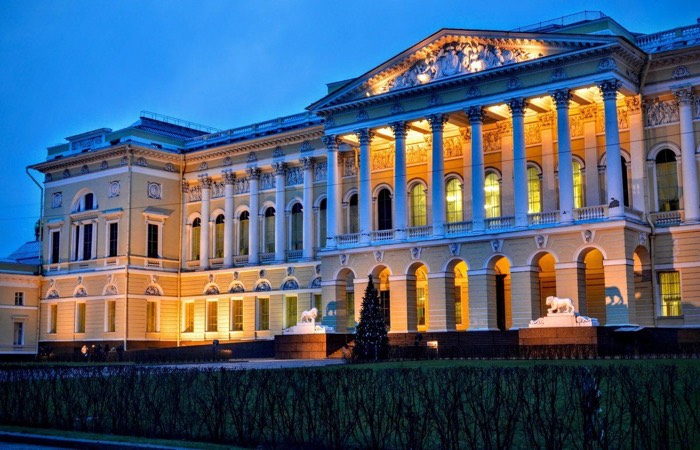Mikhailovsky Palace (Russian Museum)
Emperor Paul I decided to build the Mikhailovsky Palace for his youngest son, Prince Mikhail Pavlovich, and ordered to save money for it. Despite the fact that Paul I was killed during a palace coup and did not witness the realization of his idea, Emperor Alexander I built a palace for 21-year-old Mikhail designed by the famous architect Karl Rossi. After considering several proposals concerning the location of the future palace, we decided on the construction of a vacant lot located in the center of St. Petersburg.When the site of the future palace was approved by the emperor, Rossi created a project of an entire architectural ensemble, including the main palace building and two side wings. In addition to the palace itself, it was planned to create Mikhailovskaya Square (now Arts Square) and two streets — Engineering and Mikhailovskaya. Alexander I was personally present at the laying of the building of the Mikhailovsky Palace, held in the summer of 1819. The construction of the palace was started, and all construction work was carried out exclusively in the warm season, which ensured maximum reliability of the buildings.As a result, the main palace building and two side buildings were built, one of which housed kitchens, and the second — stables. The Mikhailovsky Garden was laid out in front of the side of the palace facing the Field of Mars. In 1825, the Mikhailovsky Palace was completed, and Karl Rossi was awarded the Order of St. Vladimir. In total, the cost of the palace was 7,000,600,000 rubles, and 4,000,000 of them were spent on decoration. After the consecration ceremony, Grand Duke Mikhail Pavlovich and his wife moved to the residence from the Winter Palace.On the ground floor of the building were the private chambers of the Grand Duke, which included six rooms, including the Arsenal, where the collection of weapons was stored. In this Arsenal there were combat guns, presented to his brother by Nicholas I. They played a historical role in the uprising of 1825 on the Senate Square. The apartments of the courtiers were also located on the ground floor. On the second floor there was a living room, an office, a library and a reception room. In the ceremonial rooms, to which the Grand Staircase led, there were halls designed for receptions and balls. On the second floor, in the very center of the suite, there was a White Hall, the design of which was particularly impressive.
The Mikhailovsky Palace soon became known in many European countries. So, King George IV of Great Britain sent a request to the Emperor of Russia to make a model of this palace for him. Russian master Nikolai Tarasov built a model measuring two meters long and two meters wide, which was taken to England.The interior decoration of the Mikhailovsky Palace struck with its taste and splendor: stunning sculptures and tapestries, paintings and stucco, wallpaper produced at the Tsarskoye Selo factory, which are a real work of art, parquet made of red, sakhardan, black, chefrazov and purple wood varieties.The great Prince Mikhail Pavlovich arranged balls in the Mikhailovsky Palace, which were in no way inferior to the imperial ones. All foreigners who visited there were impressed by the brilliance of these balls and receptions, the number of guests, music and dancing, flowers and viands. For several generations, the palace flourished, but in 1894 it was turned into an apartment building. Witte made a proposal to place a Russian museum in it, which happened in 1895. The Mikhailovsky Palace was somewhat rebuilt, the stables were demolished, and instead of them in the first decade of the XX century, a building was built here, which housed the Ethnographic Department of the museum. The opening of the Russian Museum took place in 1898.During the Great Patriotic War, the building of the Russian Palace was damaged by shells, but restored in the post-war years. During the blockade, every effort was made to preserve museum valuables: The monument to Alexander III standing in the courtyard of the Mikhailovsky Palace was reliably protected from bombs by covering it with sand and covering it with logs.The Prussian Museum is one of the largest museums in Europe, which presents rich collections of works by famous artists.
Address
st. Engineering, 2-4
Address
st. Engineering, 2-4
Address
st. Engineering, 2-4
Timetable
Mon 10:00 — 20:00, Wed, Fri—Sun 10:00 — 18:00, Thu 13:00 — 21:00
Timetable
Mon 10:00 — 20:00, Wed, Fri—Sun 10:00 — 18:00, Thu 13:00 — 21:00
Timetable
Mon 10:00 — 20:00, Wed, Fri—Sun 10:00 — 18:00, Thu 13:00 — 21:00
Phone
+7 812 595-42-48
Phone
+7 812 595-42-48
Phone
+7 812 595-42-48
Website
Mikhailovsky Palace (Russian Museum)
Website
Mikhailovsky Palace (Russian Museum)
Website
Mikhailovsky Palace (Russian Museum)
Source
https://kudago.com/spb/place/mihajlovskij-dvorec/
Source
https://kudago.com/spb/place/mihajlovskij-dvorec/
Source
https://kudago.com/spb/place/mihajlovskij-dvorec/


